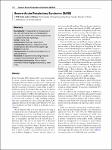Item Infomation
Full metadata record
| DC Field | Value | Language |
|---|---|---|
| dc.contributor | Vikas Gupta. | - |
| dc.contributor.author | Alexander Hodgens | - |
| dc.date.accessioned | 2024-02-28T08:24:14Z | - |
| dc.date.available | 2024-02-28T08:24:14Z | - |
| dc.date.issued | 2023 | - |
| dc.identifier.uri | http://thuvienso.thanglong.edu.vn//handle/TLU/9372 | - |
| dc.description.abstract | A new and rapidly progressive respiratory syndrome termed severe acute respiratory syndrome (SARS) was identified by the World health organization (WHO) in the Guangdong province of China as a global threat in March of 2003. SARS went on to spread globally over the following months to over 30 countries and became the 1st pandemic of the 21st century. It showed that the dissemination of an infectious microbe could be drastically increased in the era of globalization and increased international travel. The decade preceding the SARS outbreak featured the emergence of multiple novel pathogens, including H5N1 influenza, Hantavirus, Nipah virus, and Avian flu | vi |
| dc.format.extent | 9ps | vi |
| dc.language.iso | en | vi |
| dc.publisher | StatPearls Publishing | vi |
| dc.subject | Severe Acute | vi |
| dc.subject | Respiratory | vi |
| dc.subject | PH547 | vi |
| dc.title | Severe Acute Respiratory Syndrome | vi |
| dc.type | Bài báo/Newspaper | vi |
| dc.identifier.doi | https://www.ncbi.nlm.nih.gov/books/NBK558977/ | - |
| Appears in Collections | Báo, tạp chí quốc tế | |
Files in This Item:



